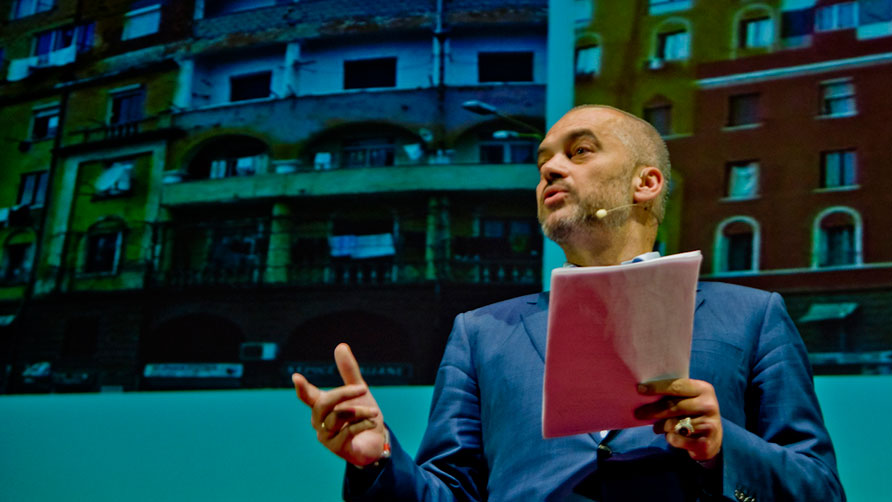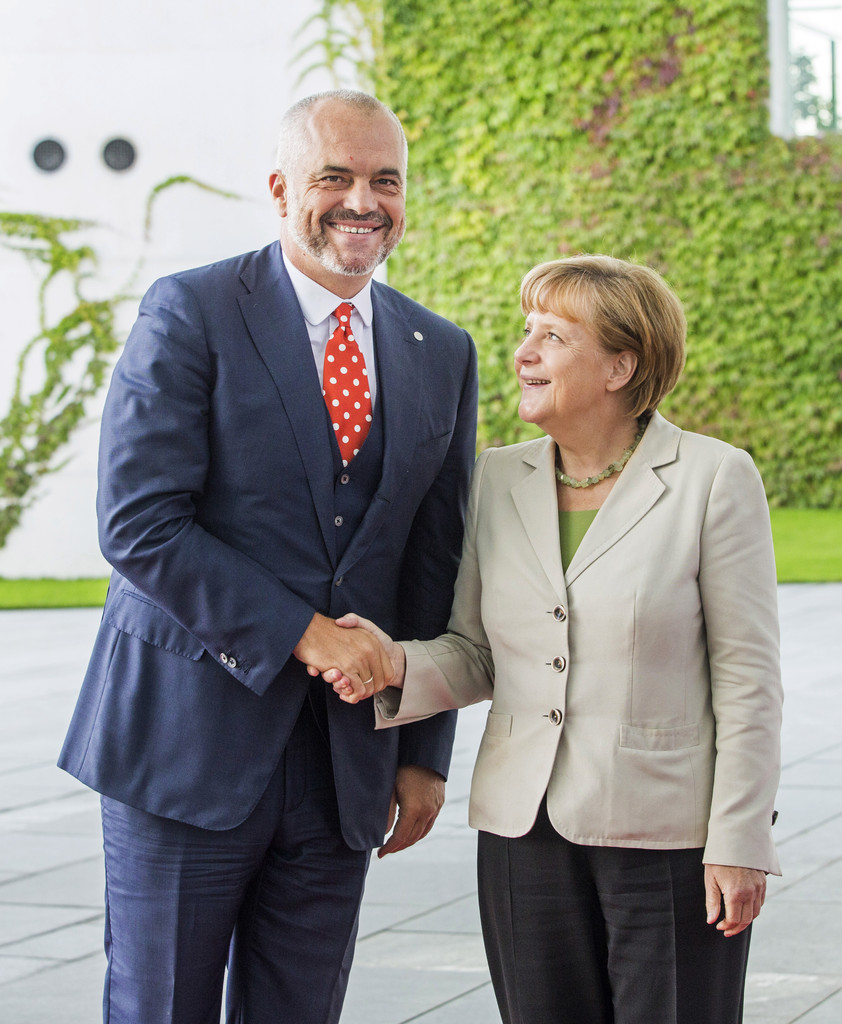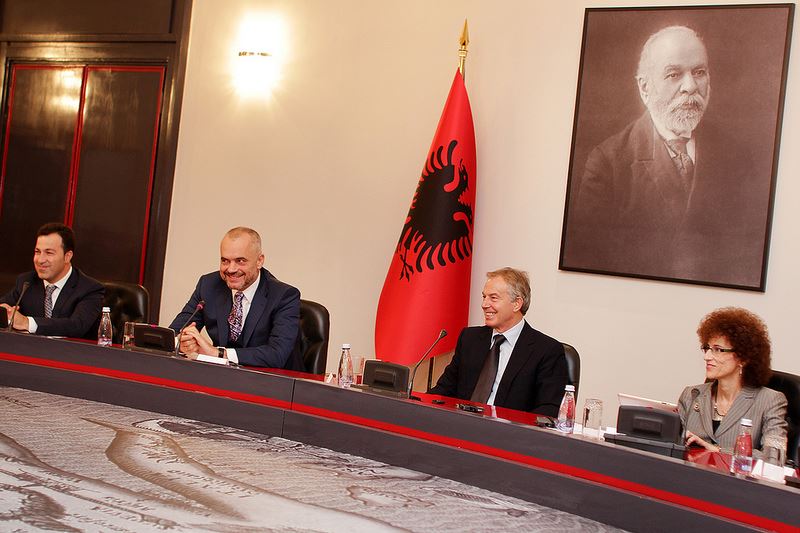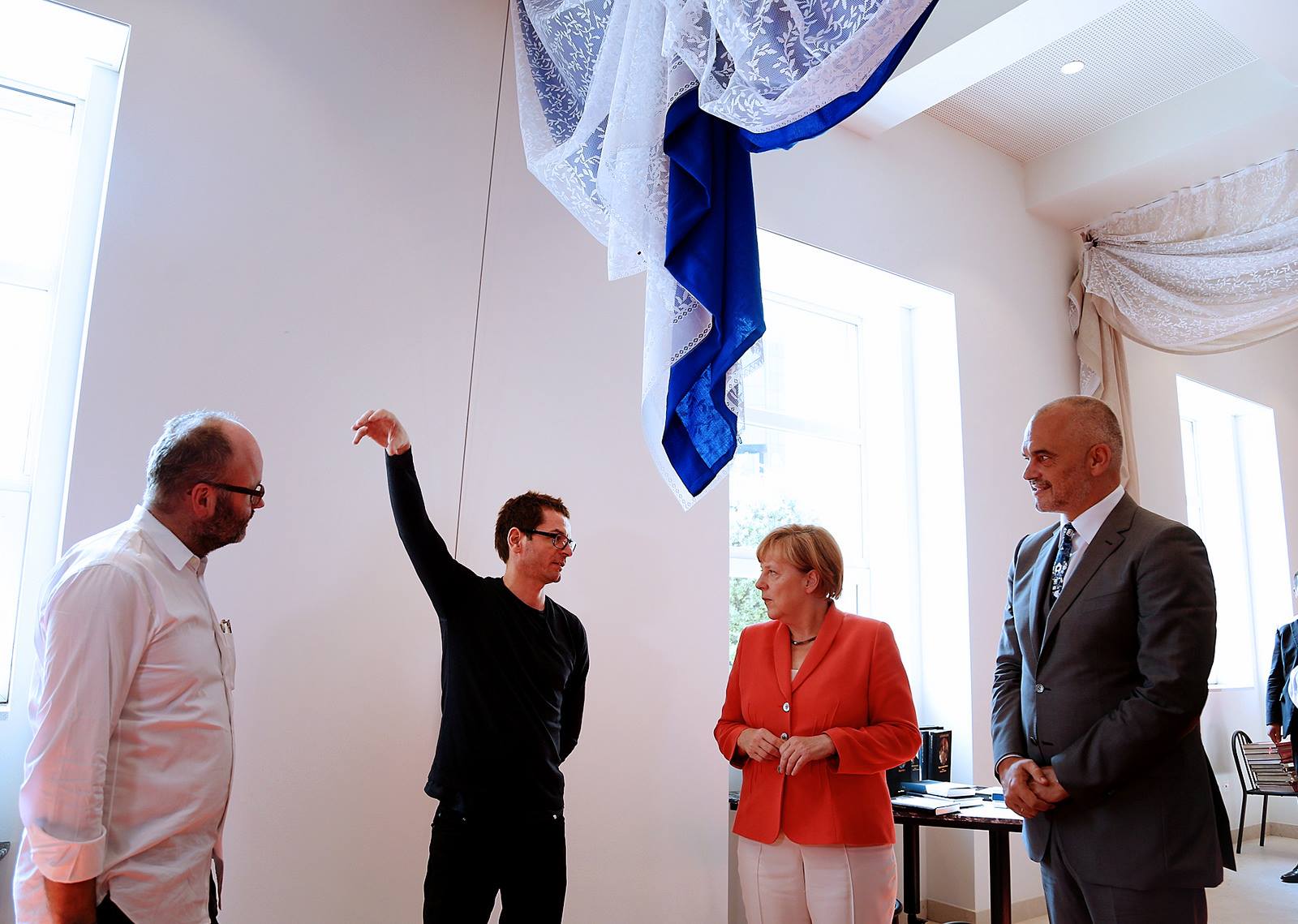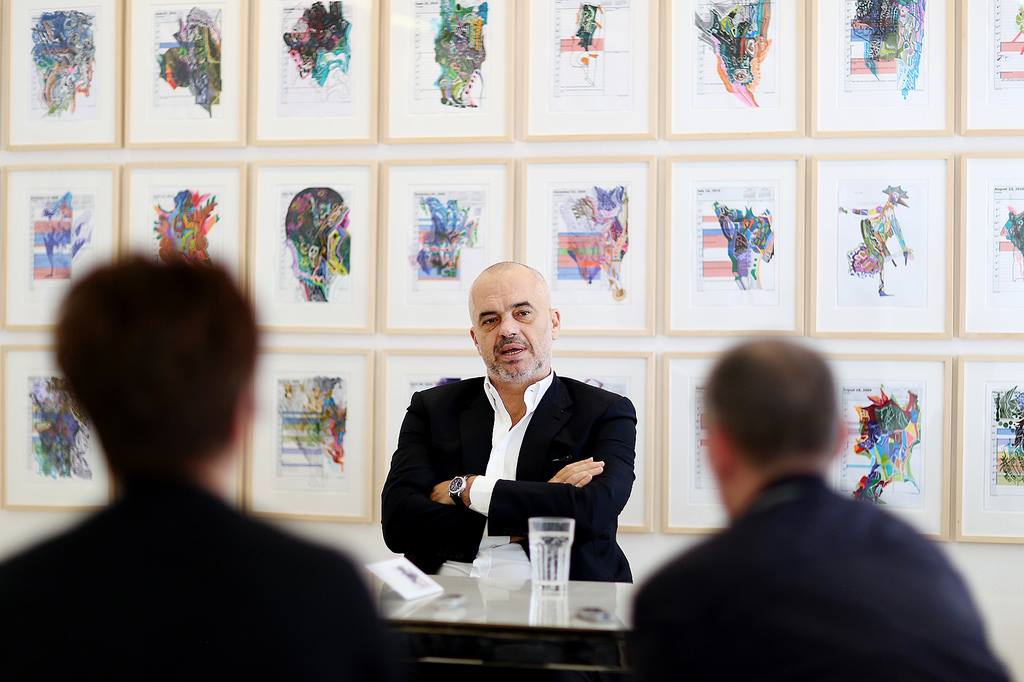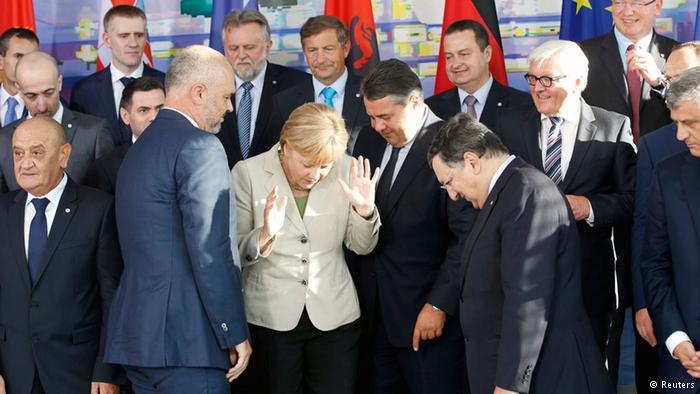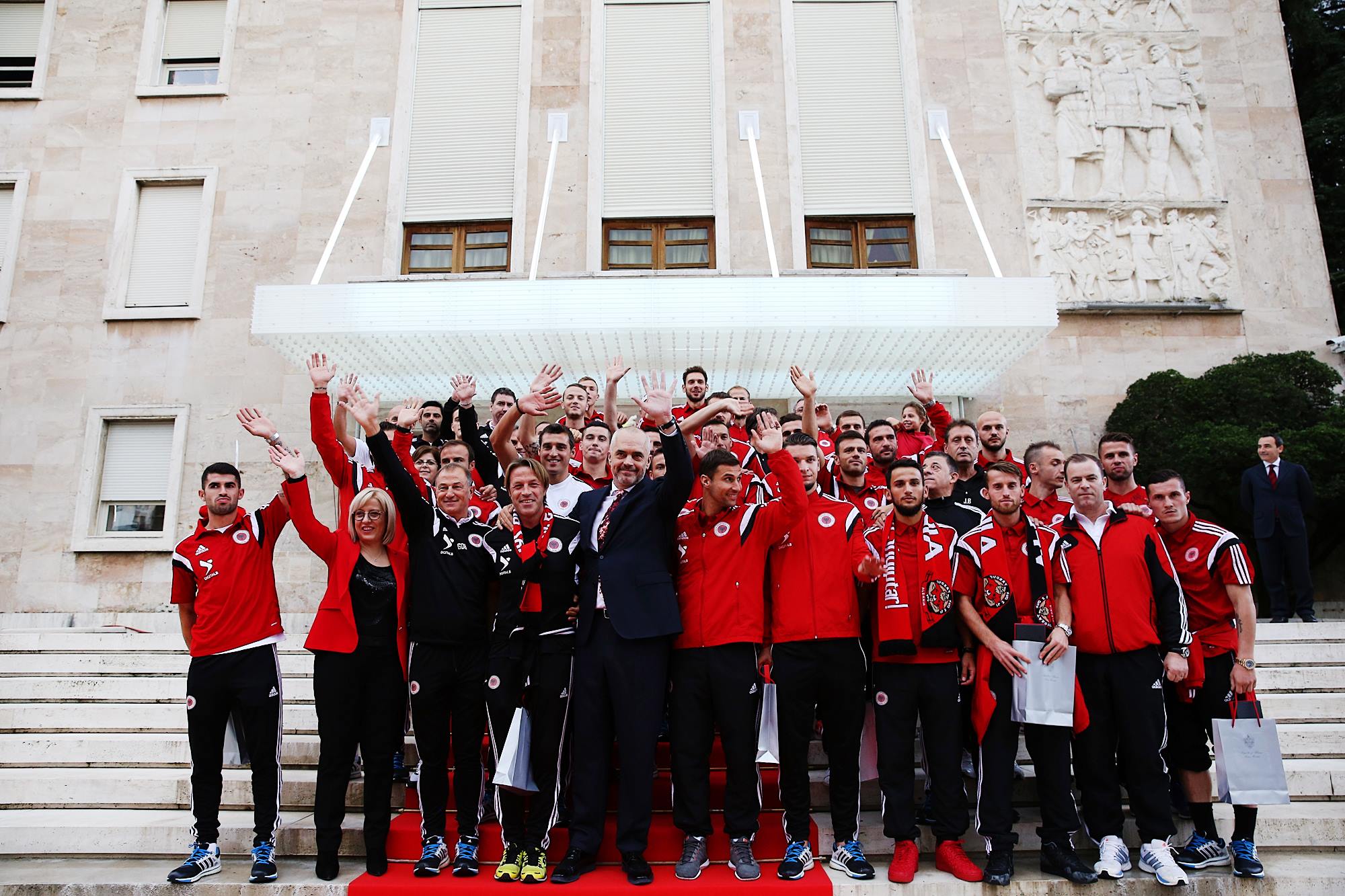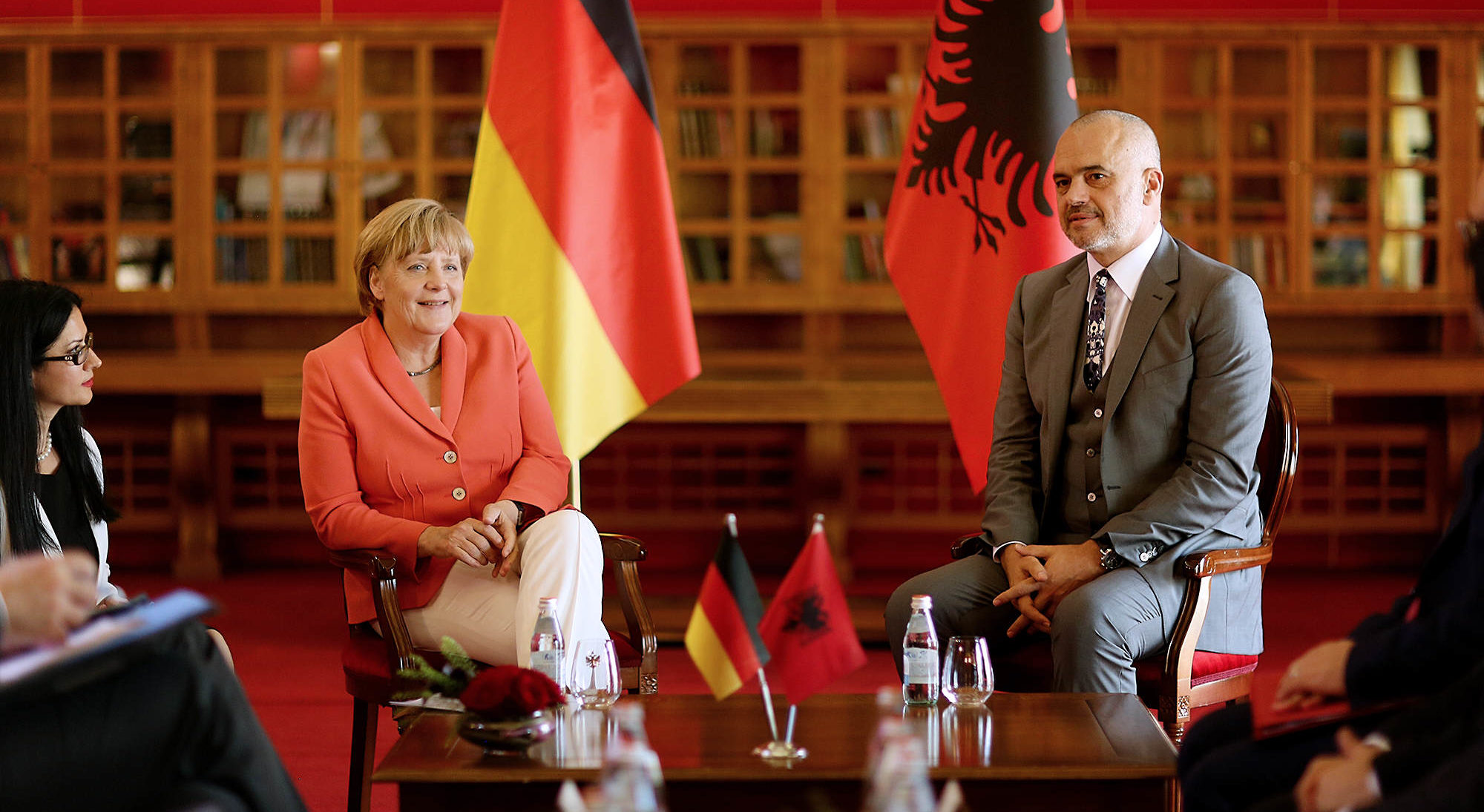
German Chancellor Angela Merkel meets with Prime Minister Edi Rama, July 2015 [photo: courtesy of Balkan Web]
Give Me the Colors . . . and the Country
Share:
“Anri, tell me the truth. Tell me that this city does not exist.
Please tell me that you do not have an artist-Mayor friend?”
—Liam Gillick
1. THE AVANT-GARDE OF DEMOCRATIZATION
Anri Sala’s Dammi i colori (2003), which opens with the above request, documents the project of Edi Rama—then mayor of Tirana, now prime minister of Albania—to paint the gray, dilapidated facades of Tirana with bright colors and patterns in an attempt to rejuvenate the city after the revolts of 1997. This widespread civil unrest was the result of a complete collapse of the economy: the capitalist shock therapy applied to Albania in the early 1990s led to a mushrooming of Ponzi investment schemes, which, once collapsed, left the majority of the population bankrupt. Dammi i colori thus documents an attempt to employ artistic practices to somehow alleviate the destructive effects of economic models that are given free rein, an attempt that could be provisionally subsumed under the practices of relational art,1 or whatever makes capitalism more beautiful.2
The difference between Rama’s initiative and other artistic practices that are referred to as “relational,” however, is that the artistic agent is here not a mere artist, but an “artist-Mayor.”3 Gillick’s incredulity toward the existence of such a figure seems to reflect an unstated desire, which is in fact as old as the avant-garde itself: that the artist might wield political influence.4 When Gillick implores Sala, “tell me it isn’t true,” we find in that negatively framed request an expression of the insecure hope that an artist-politician would somehow be able not only to address the appearance or effects of an economic and political system, but to change that system itself. This desire is also clear from Rama’s own words in Dammi i colori:
What has happened is not the result of democratization but rather of the avant-garde of democratization. This is a process that precedes and co-travels with democratization of this country, this community, it is a process that is closed in itself …. I do not know how it is for others, but the relationship between the Mayor and his elector is like the relationship between the artist and the spectator.
Edi Rama, Prime Minister of Albania since 2013, at TEDx Thessaloniki, August 2010. Some rights reserved [photo: Sofia Camplioni]
The importance of the phrase “the avant-garde of democratization” is not merely, as Svetlana Boym has suggested, a “curious reversal of the Art of Monumental Propaganda that originated right after the Russian revolution,” and it is even less what she calls an “Art of Postmonumental Anti-propaganda.”5 The terms “reversal” and “anti” suggest that we are dealing here with a certain type of opposition between forms of propaganda belonging to the historical avant-garde, and Rama’s intervention on the facades of Tirana. Yet there is a more complex genealogy behind this work and its constant recurrence in Rama’s recent interviews and lectures. That we should interpret Rama’s “avant-garde of democratization” —that which “precedes democratization,” or is elsewhere characterized as “totally not democratic but bringing democratization”6—within such a genealogy of modern propaganda was made explicit in his recent profile in the Financial Times:
This is the magical power of art, believes Rama. It can change you, even if you don’t realise it. “Which is not the case with propaganda art, which lets you know that it wants to influence you. Free art influences you without letting you know you are being influenced.”7
This is a remarkable statement to come from the head of a European, democratically elected government. Although it has become widely acknowledged that not only 20th-century totalitarian states developed models of propaganda to influence their populations’ politics, the careful positioning of modernist American artists at the forefront of a Cold War cultural battle for “democracy” and “freedom,” for instance, has perhaps never been stated so frankly: the difference between totalitarian “propaganda art” and “free art” is that the latter doesn’t let you know that it is in fact propaganda.8 The invisibility of democratic propaganda as propaganda has been at the core of public relations efforts since Edward Bernays, the “father” of PR; Rama, proclaiming the “avant-garde of democratization,” openly breaks with this paradigm of obfuscation.
Yet what, precisely, is the influence that Rama attributes to his version of “free art”? In Dammi i colori, Rama notes that his coloristic intervention became the most discussed topic on the streets of Tirana—effectively masking material and earthly issues such as the spectacular corruption under the regime of former communist Fatos Nano, who was prime minister of Albania at the time. We find a parallel to such an “organization” of color in other aspects of Rama’s artistic production, for example in his book of felt-tip pen drawings, conceived and edited by Sala, where colorful doodles cover the pages of a daily planner—creating a palimpsest out of the documentary evidence of quotidian political management.9 Artistic activity thus becomes a screen behind which bureaucratic procedures and policy implementations can take place, at a remove from public scrutiny and debate.
German Chancellor Angela Merkel meets with Prime Minister Edi Rama, July 2015 [photo: courtesy of Balkan Web]
…the difference between totalitarian “propaganda art” and “free art” is that the latter doesn’t let you know that it is in fact propaganda.
2. THE MOST POWERFUL ARTIST
In 2013 Edi Rama was elected prime minister for the Socialist Party in a landslide victory over his opponent, Sali Berisha. The artist-Mayor became artist-Prime Minister. If Rama’s practice is indeed partially artistic, it is also one that includes an annual budget of more than three billion euros, a nominal monopoly on violence across the territory of a NATO member state, and extensive control over the media, juridical system, urban planning, and taxation there. The ascent of one of its own to the heights of political power has not gone unnoticed in the international art world: Rama gave a keynote lecture at the 2014 Creative Time Summit in Stockholm.10
Rama’s talk mainly dishes out the same, sympathetic anecdotes that can be read in every recent interview with the Prime Minister: the tale of the gray EU bureaucrat versus the fresh, colorful mayor; the tale of citizens’ skepticism overcome against all odds; the tale of doodling as a relatable way of concentrating during (boring) meetings. Yet the lecture also sets up the critical parallelism between artistic and political practice. Rama begins the talk by speaking of politics in terms of “painting a canvas”—”I visualize how I want our country to be, to feel”—and concludes it by returning to the same image:
How often throughout the years have we heard political leaders talking about the need to focus on the big picture? What is the big picture? It is the vision we have for the world. What does this vision constitute? It is made of the big bold strokes that are combined to deliver the change we need for the world. What does the artist have in mind as he paints a picture? He has in mind a vision of a finished work. So today as the leader of my country, I have a vision in my mind for a country that is more modern. A country whose people are more prosperous. A country whose public servants serve the people, and not those who run them. A country where public space becomes a common space. I know what it feels like and through my leadership and decisions we now make I am trying to turn this vision into reality. These are the big pictures trying to grasp the right moment to create space where there appears to be none and even impossible to have one.
Rama’s artistic method is clear—he intends to “paint the canvas” through “bold strokes” that create a “big picture” based on a “vision”—yet the precise political nature of that vision is not. Rama makes promises of modernity, prosperity, and services. We hear echoes of Walter Benjamin’s “destructive character” when he speaks of “creating space where there appears to be none.”11 Later in his lecture, the prime minister speaks of “a peaceful, prosperous Balkans, a strong Albania as part of a strong European Union”—more “bold strokes” for the country’s “big picture.” Rama continues:
Think of the forces that have led to the scaring of Europe: racism, nationalism, xenophobia. Together we can beat them. Together we can create a space for a multiplicity of cultures, beliefs, and identities, to live side by side. And here is where my life as a painter and my life as a politician diverge. When you do a painting, or when you do a doodle, when I doodle in my agenda, there comes a point where it is done. The job is finished. But in politics, the picture is never fully completed …. So, still we must hold on to the vision and persevere. And when people say, as far too often they do, that politics can never bring change, I say they are wrong. It can and it does. But of course we know that just as politics can deliver change, so politics can hamper change. Just as politics can bring peace in between peoples, it can bring conflict. Every step on the way we face choices, just like the artist: This color or that color? This brush or that brush? This space or that space? What is the picture we’re trying to paint?
Edi Rama at a cabinet meeting in Tirana chaired by Tony Blair, October 4, 2013 [via gazetadita.al]
The contrast between the supposed finitude of Rama’s own doodles versus the open-endedness of the political process embodies the aporetic incommensurability of the “canvas of politics” and “big picture” rhetoric with the actuality of political practice. Without a guiding ideology, or a certain teleology, even his artistic choices—which brush, which color—are arbitrary, even irrelevant. If the “big picture” of a peaceful and strong Albania is subject to constant adjustment, no particular choice of brush or color could decisively influence the final outcome. Instead, chances are that every brush and color would be employed at one moment or another—and as we know from Rama himself, using all colors leads to gray.
This political grayness should not fool us about the important ideological function to the arguable open-endedness of Rama’s “post-ideology.” The opening lines of his Creative Time keynote state his political points of reference with precision: he names Reagan, Thatcher, and Merkel as direct colleagues, yet tellingly refers to (left-wing, working-class) Stefan Löfven simply as an anonymous “Swedish prime minister.” Nowadays, it would seem, a professed “absence of ideology” is a code word for neoliberal, managerial politics, whose main aim is the utter depletion of the state through the privatization of most of its services and functions. Rama fits the bill.12
Rama’s New Labor-style election campaign was advised by Alastair Campbell, former spin-doctor for Tony Blair, and once Rama became prime minister of Albania, he invited his erstwhile UK counterpart to serve as an “unpaid” advisor.13 This action has much to do with Rama’s admiration for New Labor’s “Third Way” matrix of seemingly post-ideological managerial politics, which he considers, according to Campbell, to be “one of the success stories of the center-left in Europe of our lifetime.”14 “I really liked and really followed Bill Clinton and Tony Blair,” Rama told Sala and Obrist in a conversation punningly titled “Elected Affinities”:
I think they changed politics forever. They also made it an affair of young people. They were the avant-garde of all that came after in terms of young generations getting involved, communication, image … I was very affected by Blair and impressed by the idea of the Third Way, because it was the first anti-ideological approach, an alternative to neoliberalism, but also to socialism. You don’t privatize because you are liberal, but because it’s needed, and you don’t socialize because you’re a socialist, but because it’s needed. And in both cases, you do it because it works. If it doesn’t work, you don’t do it.15
Much has been written about Blair’s advisory roles to unsavory regimes—and his way of always somehow getting paid for it, seemingly without parliamentary oversight.16 In addition to Blair’s presence in Albanian politics, the country’s protracted implementation of the Third Way is reflected in its economic policy, which includes an austerity-based program similar to Greece’s in 2010, and IMF-imposed “automatic” budgetary cuts that are rushed through the Council of Ministers without democratic debate.17 Yet, while indicators point at economic slowdown and increasing levels of public debt,18 few decisions are actually up for open debate or critical consideration.19
Edi Rama. Daily Drawings. 11 September – 10 October 2015. Gallery Kampl, Munich [photo: courtesy of Gallery Kampl]
Edi Rama. Daily Drawings. 11 September – 10 October 2015. Gallery Kampl, Munich [photo: courtesy of Gallery Kampl]
In terms of urban development, the largest architecture competitions in Albania—and therefore the most lucrative tenders for the country’s mafia-dominated construction business—are organized by a governmental entity that was in reality a collaboration among the International Architecture Biennale Rotterdam, the Albanian Ministry of Urban Development and Tourism, and the architecture firm 51N4E. Not only did 51N4E win several tenders in Tirana when Edi Rama was mayor, but the Brussels-based practice also appears to have designed Rama’s private residence.20 In Belgium, former 51N4E partner Peter Swinnen was dismissed from his position as official architect of Flanders after an audit revealed suspect relations with the Albanian government.21 One active partner, Freek Persyn, has stated that Atelier Albania, as this “collaboratory” is called, is “pushing a set of urgencies.”22 Another partner, Johan Anrys, sits on the executive board of Tirana’s new Center for Openness and Dialogue (COD)—alongside Sala, Philippe Parreno, Maja Hoffmann, and Rama himself—an initiative that includes a public archive and exhibition space located in the entrance hall to the Prime Minister’s offices.23
None of this is particularly upsetting or surprising. Corporate kickbacks, conflicts of interest, and various degrees of corruption are natural components of any “transitioning” economy; yet we imagine them magically fading away with the advent of a truly free and open market and state of law—an idea held tightly to Europe’s “post-ideological” bosom. It is equally unsurprising that Tony Blair and his henchmen have found yet another marginal country to prey on. What makes all of this problematic is that these practices appear to be condoned, and in fact actively supported, by a group of renowned and well-respected artists, curators, and architects who have allied themselves with the very specific type of state propaganda forged by Rama—propaganda that does not revolve around the concept of the “New Man” (communist propaganda) or “freedom” (democratic propaganda) but rather around precisely the contradiction in Rama’s parallel between art and politics: the latter’s “open-endedness.”
The alliance between a type of contemporary art that champions this “open-endedness” and Albanian politics articulated by Rama deserves a long-overdue scrutiny and critique—just as Albanian socialist realist artists are still held accountable for their complicity with the former regime and American abstract expressionists should be held co-responsible for their complicity in the bloody coups performed in the name of freedom and American exceptionalism they espoused. An accomplice in neoliberal statecraft offering a modicum of creativity and esthetic resistance, “free art” works better than propaganda. As Rama might put it, this art is no longer just decorative “lipstick,” but a vital “organ.”
Artist Anri Sala (in black) speaks to Angela Merkel, Edi Rama, and Thomas Demand in the new library at the office of the Prime Minister, Tirana, July 9, 2015 [© Gazeta Dita, via gazetadita.al
3. THIRD WAY PROPAGANDA
Edi Rama opened the COD at the occasion of Angela Merkel’s state visit to Albania on July 8, 2015. The opening of this digital archive, library, and exhibition space—and its location on the ground floor of Rama’s office, the Kryeministria, a monumental building along Tirana’s Boulevard of the Martyrs of the Nation—led to a prolonged discussion among Albania’s cultural players to contextualize and analyze the space, and its implications.24 In photos on Rama’s Facebook page we find Anri Sala and Thomas Demand introducing the COD to the German Chancellor. Liam Gillick was also present at this meeting of arts and politics (though he was neither an exhibiting artist nor mentioned as a collaborator in the project), which one of the artists present described as “surreal.”25 Later that day, media coverage was dominated by Rama and Merkel’s press conference, which took place in front of Demand’s Sign (2015): a photograph depicting, according to a curatorial statement from the COD, “a workshop scene where a sign is being produced for … New York’s World Fair Building [the] World of Tomorrow from 1939.”26
In addition to three works by Demand, the COD’s opening exhibition incorporated Philippe Parreno’s Marquee Tirana and Carsten Höller’s Giant Triple Mushroom—two site-specific works. Höller and Parreno have done more than exhibit at the COD: both artists donated their work to the center, and the latter has taken a seat on its executive board alongside Rama, Sala, Campbell, Anrys, Chief Curator of the Centre Pompidou and Curator of the 2017 Venice Biennial Christine Macel, World Bank official Tahseen Sayed, and others. The center is currently the best-equipped and best-designed contemporary art space in Albania, whereas the country’s National Gallery of Arts’ budget is not even sufficient to conserve its unique collection of socialist realism.27 The function of the COD is thus clear: it is a propagandistic prestige project aimed at a culture-loving outside world, not at the cultural health and preservation of Albania. So why would internationally renowned and respected artists such as Demand, Gillick, Höller, and Parreno (all white, male, midcareer, and middle-aged, which explains part of their ideological blindness) align themselves with a project of such a questionable nature?
The above artists’ support for Rama’s propaganda may be more than incidental—viewed from the perspective of Bourriaud’s “Relational Aesthetics,” in fact, it is intrinsically tied to the movement’s modes of thinking about the relations between art and politics.28 This is illustrated in an exchange between Gillick and the art theorist Claire Bishop, which has the virtue of clarity. There is however no pretense to be exhaustive here, or to differentiate between the various practices of the artists who have attended Rama’s court; this is a provisional attempt to situate a consideration of relational art in the context of propaganda studies.
Artist Anri Sala (in black) speaks to Angela Merkel, Edi Rama, and Thomas Demand in the new library at the office of the Prime Minister, Tirana, July 9, 2015 [© Gazeta Dita, via gazetadita.al
In her article “Antagonism and Relational Aesthetics,” art theorist Claire Bishop contends that relational art—exemplified by the curatorial practices of Bourriaud and Hans Ulrich Obrist, and artistic practices such as those of Gillick, Parreno, Höller, and Rirkrit Tiravanija—represent an inversion of “the goals of Greenbergian modernism,” resulting in open, public, “(col)laboratory” works that produce social relations and develop communicative situations.29 Rama’s Center for Openness and Dialogue follows the same paradigm: according to the COD’s opening curatorial statement, it “seeks to become a laboratory that investigates the very threshold where different fields of art, politics, and research meet their potential overlap.”
By the very nature of their practice, the precise political commitments of artists grouped under relational aesthetics are fluid. Its proponents believe, unlike Institutional Critique practitioners such as Andrea Fraser, that “a sequence of veils and meanderings might be necessary to combat the chaotic ebb and flow of capitalism,” and that artists must become “skeptical shape-shifters in relation to the dominant culture.”30 Proper criticism and skepticism certainly befit the artist working with precarious subjects and struggling at the receiving end of asymmetric power structures. Yet at the moment these strategies are welcomed and appropriated by political power, they rapidly form an irresponsive and irresponsible attitude (as was the case when Rama’s cultural politics resulted in artists such as Sala, Parreno, Höller, and Tiravanija being invited to “stroll” around the country—a “fun” place—and think up unconventional institutions, the COD supposedly being one of them).31 In a rather ironic twist, then, the Greenbergian modernism that furnished American mid-20th-century art with the veneer of individual freedom and apolitical, autonomous experiment, has in its reversal allowed its post-political veils and meanderings, its self-reflexive strategies of delay, dérive, and playful intervention, to become the smoke screens of post-ideological propaganda.
Institutionally critical and participatory modes of artistic practice that encourage the political clarity disdained by Gillick, and that are often informed with ideologically explicit calls from postcolonial, feminist, or other progressive lines of thought, have been embraced by all kinds of activist groups and emancipatory movements; this affinity has granted such practices at least the possibility of political influence—offering a glimpse of that old avant-garde promise of art’s ability to change the world. Contrarily, the art-theoretical precepts and artistic practices of relational art until recently found no such allies. This condition is not surprising: once deployed in politics, these precepts and practices prove to be incommensurable with such fixtures as the professed transparency of democratic government so desired by EU bureaucrats. Relational art’s rejection of transparency as the alleged sign of the totalitarian oppressor translates into a passive encouragement of corruption and backdoor deals. Its high-theoretical inaccessibility becomes a smoke screen for political arrogance. Its deregulated, rhizomatic form fosters conflicts of interest.32
None of this is problematic as long as relational art stays at arm’s length from actual political decision-making processes. But in allying themselves with Rama’s revivalist Third Way post-ideological project, relational artists have done precisely that. In the same way that the Third Way pretends to be a necessary and inevitable corrective to the unfeasible utopias of socialism, relational art suggests a necessary correction of the dogmatism and “teleological doctrines” of 20th-century avant-gardes,33 while offering some kind of “light” version of it.34 Furthermore, we are not speaking here of what Bishop has described as relational art’s embrace by community-based practices as a form of “soft social engineering” during Tony Blair’s regime.35 The artworks on display at the COD aren’t there to engineer anything but an image of progress and prosperity. They are there as self-fulfilling propaganda for openness and dialogue, just as ubiquitous depictions of the “New Man” used to populate Albanian socialist realism, though he never actually existed.36
German Chancellor Angela Merkel meets with Prime Minister Edi Rama, July 2015 [photo: courtesy of Balkan Web]
There may well be some “elected affinities” between Rama’s “avant-garde of democratization” and certain aspects of Albanian totalitarian propaganda—not only in terms of the openness with which the former expresses its aims and convictions, but also in the way it functions. An important and wide-ranging aspect of the Albanian Cultural and Ideological Revolution of the late 1960s was what Ramiz Alia, former Secretary for Ideology and Culture, called “monumental propaganda”: “a powerful instrument for the reflection of the glorious history of our people and for the revolutionary and class education of the masses.”37 This emphasis on monumentality, which left its traces in the most remote villages in the country, continues to exert its influence at the Center for Openness and Dialogue, most prominently in Parreno’s Marquee Tirana, installed on the facade the Kryeministria.38 According to the curatorial statement, the work acts as a “wordless sign or label … ghostlike … seeming to invite visitors in for a show rather than a visit.” Whereas a visit would indeed imply dialogue and personal interaction, Parreno’s work explicitly suggests the opposite: a unilateral spectacle of unknown content or duration.
The ostentatious and luminous showing of Parreno’s work, however, has the perhaps unintended side effect of emphasizing its own contrast with another artwork on the front of the building: a 1974 tripartite bas-relief depicting the National Liberation War, the building of socialism, and the reconstruction of the country—co-authored by Kristaq Rama, Edi Rama’s father and the most prominent sculptor of the Albanian communist regime.39 The function of Marquee Tirana is therefore not merely to invite and to welcome, but also to dominate, in brightness and in size, the project of the workers, farmers, and soldiers depicted in the bas-relief by bathing them in a continuous stroboscope of automated LEDs, as if to put the past itself in one of the infamous American torture chambers of today. This part of the message is clear: we have arrived not only at a new, grander political regime; the visual regime has changed, too. Art historian Raino Isto has pointed out the apparent contradiction between the fact that the works exhibited at the COD, in spite of their intention to create relations and invite dialogue, are experienced as objects, not interlocutors or platforms.40 These works have been appropriated into a schema of presentation that aims to feign openness and dialogue—not to actually engage in these things, but instead to dominate them.
Perhaps the above-mentioned artists relate to the Rama government in the following “broad strokes”: if we contrast the propaganda of 20th-century totalitarian states, fascist or communist—which still makes the rounds in museum spaces of the West as an exotic curiosity—with the “democratic” propaganda of Bernays’ public relations industry and institutions such as the Congress for Cultural Freedom, we may term the forms of relational art that Rama has appropriated as “Third Way propaganda.”41 From totalitarian propaganda, it inherits an open acknowledgment of its function as such; from the democratic one, its preference for cutting-edge contemporary art.
The insidious and thus productive aspect of such an appropriation is that for the international and cultured elite inside and outside Tirana, it is very difficult to reject such an ostentatious display of relationality, openness, and fostering of dialogue as an ideological choice—particularly one intended to mask political decisions that are made with questionable democratic content; and that are deliberately difficult to access and assess,42 particularly for anyone outside the country. As Bishop notes, “The quality of the relationships in ‘relational aesthetics’ are never examined or called into question.” She continues her critique: “all relations that permit ‘dialogue’ are automatically assumed to be democratic and therefore good. But what does ‘democracy’ really mean in this context? If relational art produces human relations, then the next logical question to ask is what typesof relations are being produced, for whom, and why?”43
It is the absence of any such qualification of these relationships that has let relational aesthetics be appropriated to a point where its only dialogue seems to be with a socialist realism generally presumed extinct. The “first and foremost … democratic concern” that Bourriaud attributes to relational art can tragically easily turn into its precise opposite, all the while masking its fall. That’s precisely why it’s so useful. So, white, male, midcareer, middle-aged cultural producers: Please tell me that you do not have an artist-Prime Minister friend!
Edi Rama celebrates Albania’s qualification for the UEFA EURO 2016 with the Albanian national soccer team, January 16, 2016 [© TeleSport, via telesport.al]
This article condenses and elaborates several themes previously developed on the blog, “The Unofficial View of Tirana,” formerly hosted by continent.journal and currently under the auspices of Berfrois. I wish to thank the editors of both venues for the opportunity to continue to write freely on topics pertaining to the arcane realm of Albanian cultural politics. An earlier version of this paper was presented in the context of the Nationless project, December 6, 2015, Skopje, Macedonia. I would also like to thank my friend and colleague Jonas Staal for many fruitful and stimulating exchanges on the question of propaganda in the 21st century.
Vincent W.J. van Gerven Oei is a philologist with a background in music composition, linguistics, conceptual art, and philosophy. He studied under Avital Ronell at the European Graduate School and Christopher Fynsk at the Centre for Modern Thought. Van Gerven Oei is co-director of punctum books, and directs the project bureau for the arts and humanities The Department of Eagles in Tirana, and the multilingual publishing house Uitgeverij. He is founding editor of Dotawo: A Journal of Nubian Studies, and a fellow at the European Graduate School.
References
| ↑1 | Rirkrit Tiravanija, Hans Ulrich Obrist, and Molly Nesbit, Utopia Station, 2003: www.e-flux.com/projects/utopia/index.html |
|---|---|
| ↑2 | Hito Steyerl, “Politics of Art: Contemporary Art and the Transition to Post-Democracy,” The Wretched of the Screen (Berlin: Sternberg Press, 2012): 93. |
| ↑3 | See Nicolas Bourriaud, Relational Aesthetics, trans. Simon Pleasance and Fronza Woods with Mathieu Copeland (Paris: Les presses du réel, 2002 [1998]). |
| ↑4 | See David L. Dowd, “Jacques-Louis David, Artist Member of the Committee of General Security,” The American Historical Review 57.4 (July 1952), 871-878. Freek Persyn, an Albanian partner at the architectural and concept design collective 51N4E, expressed this political desire during a round table at the Swiss Pavilion of the 14th Architecture Biennale in Venice, when he imagined himself becoming “more of a Prime Minister” and promoter of his country:www.youtube.com/watch?v=q1BBbjyYPaE |
| ↑5 | Svetlana Boym, “Modernities Out of Sync: The Tactful Art of Anri Sala,” ARTMargins, February 23, 2005: www.artmargins.com/index.php/2-articles/177-modernities-out-of-sync-the-tactful-art-of-anri-sala |
| ↑6 | See Okwui Enwezor, Rem Koolhaas, and Hans Ulrich Obrist, “A stroll through a fun palace,” a talk that took place during a Marathon (June 5-6, 2014) at the Swiss Pavilion of the 14th Architecture Biennale in Venice: youtu.be/z8uyl0eenDk?list=PLB7aMaI62OFdXhqdYZkrQA_x_U4503pxW |
| ↑7 | Peter Aspden, “The art of nation-building in Albania,” Financial Times (July 17, 2015):www.ft.com/intl/cms/s/2/665ebc22-2af5-11e5-8613-e7aedbb7bdb7.html#slide0 |
| ↑8 | I borrow this distinction between totalitarian and democratic propaganda from Jonas Staal, “Art. Democratism. Propaganda.” e-flux journal 52 (2014): www.e-flux.com/journal/art-democratism-propaganda. See also Igor Golomstock, Totalitarian Art in the Soviet Union, The Third Reich, Fascist Italy, and the People’s Republic of China (New York: Overlook Duckworth, 2011); Boris Groys, The Total Art of Stalinism: Avant-Garde, Aesthetic Dictatorship and Beyond (London/New York: Verso, 2011); Eva Cockroft, “Abstract Expressionism, Weapon of the Cold War,” ArtForum 15.10 (June 1974), 39-41. |
| ↑9 | Edi Rama, 2000-2009 (Tirana: Toena, 2009). Rama has since acquired the habit of presenting his doodles during official or business visits. See Vincent W.J. van Gerven Oei, “The Unofficial View of Tirana (97),” Berfrois (November 13, 2015): www.berfrois.com/2015/11/vincent-w-j-van-gerven-oei-winning |
| ↑10 | See “Creative Time Summit | Keynote: Edi Rama”: www.youtube.com/watch?v=2sbs0pf0OXs |
| ↑11 | Walter Benjamin, “The Destructive Character,” in Selected Writings, Vol. 2, part 2, 1931-1934, ed. Michael W. Jennings et al. (Cambridge, MA: Belknap Press of Harvard University Press, 1999): 541-542. |
| ↑12 | This is reminiscent of Eurogroup chairman Jeroen Dijsselbloem’s motto: “If I get into the ideological side of things, I won’t achieve anything.” See Thijs Broer and Map Oberndorff, “‘Als ik ideologische verhalen ga houden, bereik ik niks,’” Vrij Nederland (June 3, 2015): www.vn.nl/als-ik-ideologische-verhalen-ga-houden-bereik-ik-niks; Slavoj Zizek, “This is a Chance for Europe to Awaken,” New Statesman (July 6, 2015): www.newstatesman.com/politics/2015/07/Slavoj-Zizek-greece-chance-europe-awaken |
| ↑13 | Will Nicoll, “Edi Rama’s Albanian Renaissance,” Newsweek (August 18, 2015):http://europe.newsweek.com/edi-ramas-albanian-renaissance-331699. See also Adam Curtis’ documentary film The Century of the Self (2002) on the link between Bernays’ public relations and Campbell’s Third Way stratagems, and BBC series The Trap (2007), on Blair’s role in the Kosovo War. |
| ↑14 | “Why has Albania hired Tony Blair as an adviser?” The Guardian (October 6, 2013):www.theguardian.com/world/2013/oct/06/albania-hired-tony-blair-adviser |
| ↑15 | “Elected Affinities: Hans Ulrich Obrist talks with Edi Rama and Anri Sala,” ArtForum (February 2014): www.artforum.com/inprint/issue=201402&id=45004 |
| ↑16 | See Murtaza Hussain, “Tony Blair is Terrible at Promoting Human Rights, Great at Enriching Himself,” The Intercept (March 17, 2015):www.firstlook.org/theintercept/2015/03/17/strangeworld-tony-blair; Robert Mendick and Besar Likmeta, “Cherie Blair signs deal to act for Albania where her husband is official advisor,” The Telegraph (March 7, 2015): www.telegraph.co.uk/news/politics/tony-blair/11457121/Cherie-Blair-signs-deal-to-act-for-Albania-where-her-husband-is-official-adviser.html; Edward Malnick, Claire Newell, and Robert Mendick, “Revealed: The true scale of Tony Blair’s global business empire,” The Telegraph (June 11, 2015): www.telegraph.co.uk/news/politics/tony-blair/11668401/tony-blair-global-business-empire-taxpayers-money.html |
| ↑17 | “Albania: World Bank Group Partnership Program Snapshot,” April 2015:www.worldbank.org/content/dam/Worldbank/document/eca/Albania-Snapshot.pdf |
| ↑18 | See for a particularly bleak picture the IMF’s “Financial Transparency Evaluation” (January 2016): www.imf.org/external/pubs/ft/scr/2016/cr1605.pdf |
| ↑19 | See Gjergj Erebara, “Kuvendi fillon diskutimin e buxhetit ne¨ mungese¨ totale transparence,” Reporter (November 19, 2015): www.reporter.al/kuvendi-fillon-diskutimin-e-buxhetit-ne-mungese-totale-transparence |
| ↑20 | 51N4E has not publicly acknowledged constructing Rama’s private residence, but architectural sketches of “a single family house and atelier” for a private clientÑsupposedly in Amorgos, Greece, yet carefully matching the architecture and surrounding landscape and infrastructure of Rama’s house in Surrel, Albania—ëwere published in 51N4E’s exhibition catalogue Double or Nothing(Architectural Association, 2011). |
| ↑21 | Alan Hope, “Official architect Peter Swinnen dismissed with immediate effect,” Flanders Today(February 4, 2015): www.flanderstoday.eu/current-affairs/official-architect-peter-swinnen-dismissed-immediateeffect |
| ↑22 | See “A Stroll through a Fun Palace,” from 00:13:15. Persyn naively praises Albania’s “informal economy” (00:14:25), which has recently been under aggressive attack by Rama’s government in the hope of raising tax revenues to balance the IMF-imposed budget. This is one example of the mismatch between artistic discourse positioning Albania as a space for progressive development and the government practices that appropriate it for propagandistic aims. |
| ↑23 | www.cod.al/?page_id=21 |
| ↑24 | See Gentian Shkurti, Alban Hajdinaj, and Eriola Pira, “Parreno i kapur në monolog,” Peizazhe të fjalës (July 13, 2015): http://peizazhe.com/2015/07/13/parreno-i-kapur-nemonolog/; Vincent W.J. van Gerven Oei, “The Unofficial View of Tirana (92),” Berfrois (July 13, 2015):www.berfrois.com/2015/07/vincent-w-j-van-gerven-oei-all-that-frustration; Raino Isto, “Image //Anti-Image,” afterart (July 18, 2015): https://afterart.wordpress.com/2015/07/18/image-anti-image; Ardian Vehbiu, “Psikodrama e hapjes,” Peizazhe të fjalës (July 23, 2015):http://peizazhe.com/2015/07/23/psikodrama-e-hapjes; Elidor Mëhilli, “Pak diktaturë për të gjithë,”Gazeta Shqip (July 29, 2015): http://gazeta-shqip.com/lajme/2015/07/29/pak-diktature-per-te-gjithe; Fatos Lubonja, “Art-politika e Ramës si pervertim i të dyjave,” Përpjekja (August 5, 2015): http://perpjekja.blogspot.al/2015/08/art-politika-e-rames-si-pervertim-i-te.html; Nicola Pedrazzi, “Politics, Contradictions and Art: Two Years of the Rama Show,” Kosovo 2.0 (August 18, 2015):www.kosovotwopointzero.com/en/article/1804/politics-contradictions-and-art-two-years-of-therama-show. Much of what follows is indebted to these discussions. For a more recent appraisal see Jonida Gashi, “These are (not) the things we are fighting for,” Reporter (November 29, 2015):www.reporter.al/these-are-not-the-things-we-are-fighting-for |
| ↑25 | Aspden, “The art of nation-building.” |
| ↑26 | This was the same New York World’s Fair to feature an exhibit by Edward Bernays called Democracity. |
| ↑27 | Alma Mile, “Pas deklarate¨s se¨ kuratorit holandez, GKA: Ke¨rkese¨ Ministrise¨ pe¨r godine¨ te¨ re pe¨r fondin,” Panorama (March 6, 2015): www.panorama.com.al/pas-deklarates-se-kuratorit-holandez-shabani-kerkese-ministrise-per-godine-te-re-per-fondin |
| ↑28 | Isto, afterart. |
| ↑29 | Claire Bishop, “Antagonism and Relational Aesthetics,” October 110 (Fall 2004): 54-55. |
| ↑30 | Liam Gillick, “Contingent Factors: A Response to Claire Bishop’s ‘Antagonism and Relational Aesthetics,’” October 115 (Winter 2006): 106. See also Bill Roberts, “Burnout: Liam Gillick’s Post-Fordist Aesthetics,” Art History 36.1 (Feb. 2013), 180-205. |
| ↑31 | See “A Stroll through a Fun Palace” (00:25:35). |
| ↑32 | See Simon Critchley, “The Infinite Demand of Art,” Art & Research 3.2 (Summer 2010): 4-5. Critchley suggests that relational art practices such as Gillick’s and Parreno’s are precisely the types of practices that could “get over the art/theory dichotomy in relation to a third term, like the political.” |
| ↑33 | Bourriaud, Relational Aesthetics, 45. |
| ↑34 | Bourriaud, ibid., 70. “So exhibitions of Rirkrit Tiravanija, Philippe Parreno, Carsten Höller, Henry Bond, Douglas Gordon and Pierre Huyghe all construct models of socia- bility suitable for producing human relations …. If these artists do indeed extend the idea of avant-garde thrown out with the bath water of modernity … they are not na•ve or cynical enough ‘to go about things as if’ the radical and universalist utopia were still on the agenda. In their respect, we might talk in terms of micro-utopias, and interstices opened up in the social corpus.” |
| ↑35 | Claire Bishop, Artificial Hells: Participatory Art and the Politics of Spectatorship (New York: Verso, 2012): 5, 13-14. |
| ↑36 | For recent, in-depth analyses of Albanian socialist realism, see Ge¨zim Qe¨ndro, Le surréalisme socialiste: L’autopsie de l’utopie (Paris: L’Harmattan, 2014); Isto, afterart. |
| ↑37 | Ramiz Alia, “Report on the State and Measures for the Development and Further Revolutionization of Monumental Propaganda,” Lapidari, vol. 1, ed. Vincent W.J. van Gerven Oei (Brooklyn: Punctum Books, 2015): 33. |
| ↑38 | Gentian Shkurti, Alban Hajdinaj, and Eriola Pira, “Parreno i kapur ne¨ monolog,” Peizazhe te¨ fjale¨s (July 13, 2015): www.peizazhe.com/2015/07/13/parreno-i-kapur-nemonolog. “Parreno knows very well that in this case he has done a political favor to the specific government that tries to impose itself on a poor and culturally backward country, whose public is unable to interpret his work, but also to deceive the entire world as a fervent supporter of culture! He accepts to make the ignorance of the public […] part of his work (author’s translation).” |
| ↑39 | Isto, afterart. The opening of the Center for Openness and Dialogue has, according to Isto, made a comparison between father and son Rama “unavoidable.” I agree with that assessment. |
| ↑40 | Ibid. |
| ↑41 | See Bishop, Antagonism, 69. “We could even say that Gillick’s … devotion to compromise is the ideal: an intriguing but untenable hypothesis, and ultimately less a democratic microtopia than a form of ‘third way’ politics.” |
| ↑42 | According to a report by nonprofit lawyers ResPublica and NGO Civil Rights Defenders on the implementation of the Albanian Freedom of Information Act, the Office of the Prime Minister is “the worst example,” having “not respected any legal standard,” and “no implementation of any transparency program whatsoever” (my translation). See Dorian Matlija et al., E drejta e informimit ne¨ bankoprove¨ (December 2015), 35: www.respublica.org.al/wp-content/uploads/2015/12/E-drejta-e-informimit-ne-bankoprove.pdf |
| ↑43 | Bishop, Antagonism, 65. |
